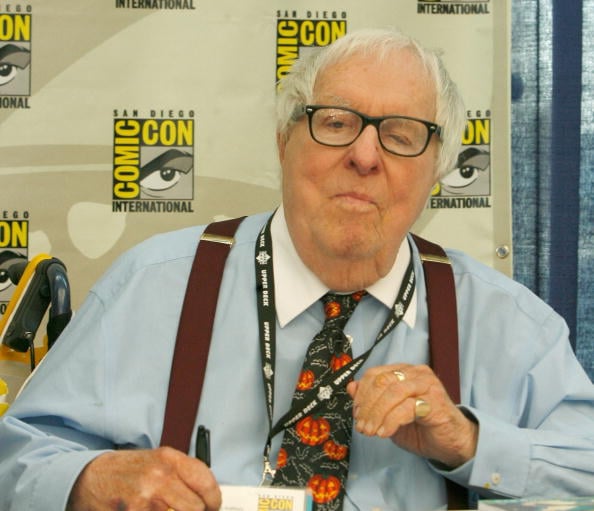What is Ray Bradbury's Net Worth?
Ray Bradbury was an American author and screenwriter who had a net worth of $30 million at the time of his death. A large portion of his net worth was attributed to the intellectual property value of his works.
Known for writing in a variety of genres, Ray Bradbury's most celebrated works include the novels "Fahrenheit 451," "Dandelion Wine," and "Something Wicked This Way Comes," and the short-story collections "The Martian Chronicles," "The Illustrated Man," and "The October Country." For the screen, Bradbury co-wrote John Huston's 1956 film adaptation of "Moby Dick."
Early Life and Education
Ray Bradbury was born on August 22, 1920 in Waukegan, Illinois to Esther and Leonard. His mother was a Swedish immigrant and his father was of English descent. From 1926 to 1927 and again from 1932 to 1933, the family resided in Tucson, Arizona, where Bradbury's father sought work. They eventually settled in Los Angeles, California in 1934. Growing up, Bradbury was an avid reader, writer, and illustrator, and spent much of his time in the library. He was inspired by such authors as Edith Wharton, Katherine Anne Porter, Edgar Rice Burroughs, and Jules Verne. In Los Angeles, Bradbury became friends with science-fiction writer Bob Olsen. After graduating from Los Angeles High School, he met author Robert Heinlein. Bradbury did not attend college; he felt his most formative education came from the library.
Books
Bradbury started publishing his science-fiction stories in fanzines in 1938. He continued publishing short stories over the subsequent years, and by the age of 24 he became a full-time writer. Bradbury's debut short-story collection, "Dark Carnival," was published in 1947. He went on to gain acclaim for the science-fiction short-story collections "The Martian Chronicles" (1950) and "The Illustrated Man" (1951). Bradbury published his most famous novel, "Fahrenheit 451," in 1953. Expanded from a short story he had previously published in Galaxy Science Fiction magazine, the book takes place in a dystopian future where books are outlawed and systematically burned. "Fahrenheit 451" won the American Academy of Arts and Letters Award in Literature and eventually became regarded as a classic of 20th-century fiction. Bradbury's subsequent works included the short-story collections "The Golden Apples of the Sun" and "The October Country" and the coming-of-age novel "Dandelion Wine." The latter is the first book in Bradbury's "Green Town Trilogy," based on his childhood in Waukegan. It was followed by the dark fantasy novel "Something Wicked This Way Comes," published in 1962. Over the remainder of the 1960s, Bradbury published numerous short-story collections, including "The Machineries of Joy," "The Vintage Bradbury," "Tomorrow Midnight," and "I Sing the Body Electric."
In 1972, Bradbury published the fantasy novel "The Halloween Tree." He didn't publish his next novel, "Death is a Lonely Business," until 1985. However, Bradbury did release various short-story collections in the meantime, including "Long After Midnight," "The Last Circus & the Electrocution," "Dinosaur Tales," and "A Memory of Murder." Kicking off the 1990s, Bradbury published the mystery novel "A Graveyard for Lunatics." He followed that in 1992 with "Green Shadows, White Whale," a fictionalized account of his journey to Ireland in the 1950s. Bradbury's subsequent works in the 1990s included the short-story collections "Quicker Than the Eye" and "Driving Blind." Early in the 21st century, he published the novels "From the Dust Returned" and "Let's All Kill Constance" and the collection "One More for the Road." Bradbury's final novel, "Farewell Summer," was published in 2006; it serves as a sequel to "Dandelion Wine" and the last installment in the "Green Town Trilogy." After that, Bradbury continued writing short stories and publishing collections for several years. Among his late-career collections are "The Dragon Who Ate His Tail" (2007), "Summer Morning, Summer Night" (2007), "A Pleasure to Burn" (2010), and "Killer, Come Back to Me" (2020), which was released posthumously.

Getty Images
Other Works and Activities
Beyond his books, Bradbury consulted on various screenplays, and co-wrote the 1956 film adaptation of "Moby Dick" with its director John Huston. He also worked as a playwright and headed the Pandemonium Theatre Company in Los Angeles. In the 1980s and early '90s, he hosted the television anthology series "The Ray Bradbury Theater," featuring adaptations of his short stories. Bradbury also adapted his novel "The Halloween Tree" into a 1993 animated television film, for which he won a Daytime Emmy Award. Among his myriad of other activities, he served on the advisory board of the Los Angeles Student Film Institute and was a long-time opening-night speaker for the Santa Barbara Writers Conference.
Personal Life and Death
Bradbury was married to Marguerite McClure from 1947 until her passing in late 2003. Together, they had four daughters named Susan, Ramona, Bettina, and Alexandra.
In 1999, Bradbury had a stroke that made him partially reliant on a wheelchair. He continued to write and make public appearances for the next decade. On June 5, 2012, following a lengthy illness, Bradbury passed away at the age of 91. He is interred at Westwood Village Memorial Park in Los Angeles.
/2014/08/Ray-Bradbury.png)
/2017/05/charles.jpg)
/2024/01/Kurt-Vonnegut2.jpg)
/2022/09/Truman-Capote.jpg)
/2018/02/Louis-LAmour.jpg)
/2020/01/Stephen-King.jpg)
/2017/02/GettyImages-528215436.jpg)
/2020/04/Megan-Fox.jpg)
/2020/06/taylor.png)
/2020/01/lopez3.jpg)
/2009/11/George-Clooney.jpg)
/2020/02/Angelina-Jolie.png)
/2019/11/GettyImages-1094653148.jpg)
/2019/10/denzel-washington-1.jpg)
/2019/04/rr.jpg)
/2009/09/Jennifer-Aniston.jpg)
:strip_exif()/2015/09/GettyImages-476575299.jpg)
/2014/08/Ray-Bradbury.png)
/2020/01/Stephen-King.jpg)
/2024/01/Kurt-Vonnegut2.jpg)
/2017/05/charles.jpg)
/2020/10/CNW-Man-1.png)
/2025/07/Anne-Tyler.jpg)
/2010/09/Anne-Rice.jpg)
/2018/02/Louis-LAmour.jpg)
/2009/09/Cristiano-Ronaldo.jpg)
:strip_exif()/2009/09/P-Diddy.jpg)
/2009/09/Brad-Pitt.jpg)